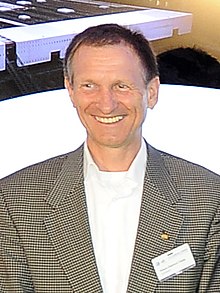Abdul Ahad Momand is a Afghan-German and former Afghan Air Force aviator who became the first, and currently only, Afghan citizen to journey to outer space.

Norman Earl Thagard, M.D., is an American scientist and former U.S. Marine Corps officer and naval aviator and NASA astronaut. He is the first American to ride to space on board a Russian vehicle, and can be considered the first American cosmonaut. He did this on March 14, 1995, in the Soyuz TM-21 spacecraft for the Russian Mir-18 mission.

Frank, Viscount De Winne is a Belgian Air Component officer and an ESA astronaut. He is Belgium's second person in space. He was the first ESA astronaut to command a space mission when he served as commander of ISS Expedition 21. ESA astronaut de Winne serves currently as Head of the European Astronaut Centre of the European Space Agency in Cologne/Germany (Köln).

Yuri Pavlovich Gidzenko is a Russian cosmonaut. He was a test cosmonaut of the Yuri Gagarin Cosmonaut Training Center (TsPK). Gidzenko has flown into space three times and has lived on board the Mir and the International Space Station. He has also conducted two career spacewalks. Although he retired on July 15, 2001, he continued his employment by a special contract until Soyuz TM-34 concluded. Since 2004 to May 2009, Gidzenko was the Director of the 3rd department within the TsPK. Since May 2009 he serves as the Deputy Chief of Cosmonaut Training Center TsPK.

Valery Grigoryevich Korzun is a Russian cosmonaut. He has been in space twice totalling 381 days. He has also conducted four career spacewalks.

Anatoly Yakovlevich Solovyev is a retired Russian and Soviet cosmonaut and pilot. Solovyev was born on January 16, 1948, in Riga, Latvia. Solovyev holds the world record on the number of spacewalks performed (16), and accumulated time spent spacewalking.

Michel Ange-Charles Tognini is a French test pilot, engineer, brigadier general in the French Air Force, and a former CNES and ESA astronaut who served from 1 January 2005 to 1 November 2011 as head of the European Astronaut Centre of the European Space Agency. A veteran of two space flights, Tognini has logged a total of 19 days in space. Tognini has 4000 flight hours on 80 types of aircraft. He is fluent in English and Russian.

Brigadier Roberto Vittori, OMRI is an Italian Air Force officer and an ESA astronaut. After graduating from the Italian Accademia Aeronautica in 1989, Vittori flew in the Italian Air Force. He then trained as a test pilot in the United States.

Soyuz TM-13 was the 13th expedition to Mir space station. Lasting from October 1991 to March 1992, the mission included cosmonauts from Austria and the soon-to-be independent region of Kazakhstan, as the Soviet Union collapsed in December 1991. The launch ceremony at the Baikonur Cosmodrome in Baikonur, Kazakh SSR was attended by the Soviet Premier Ivan Silaev, the President of the Kazakh SSR Nursultan Nazarbayev, and the Chancellor of Austria Franz Vranitzky. Before the launch, for the first time, President Nazarbayev received the launch report from cosmonaut Tokhtar Aubakirov in the Kazakh language.
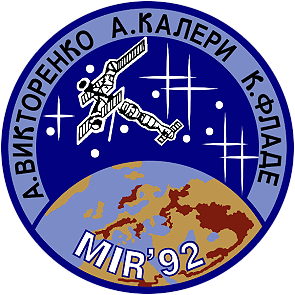
Soyuz TM-14 was the 14th expedition to the Mir space station. It included an astronaut from Germany, and was the first Russian Soyuz mission after the collapse of the Soviet Union.

Reinhold Ewald is a German physicist and ESA astronaut.

Thomas Arthur Reiter is a retired European astronaut and is a Brigadier General in the German Air Force currently working as ESA Interagency Coordinator and Advisor to the Director General at the European Space Agency (ESA). He was one of the top 25 astronauts in terms of total time in space. With his wife and two sons he lives near Oldenburg in Lower Saxony.

The German astronaut team was established in 1987. Before the establishment of the team, then-West German astronauts were selected for single missions, or as part of the European Space Agency's manned spaceflight activities. East Germany had its first cosmonaut, Sigmund Jähn; Jähn was both West and East Germany's first citizen in space when he departed from Baikonur in the Soviet Union in August and returned to Earth in September 1978. West and East Germany reunified in 1990 and the astronaut team became representative of a single German nation.

Timothy Lennart "Tim" Kopra is an engineer, a Colonel in the United States Army and a retired NASA astronaut. He served aboard the International Space Station as a flight engineer for Expedition 20, returning to Earth aboard Space Shuttle Discovery on the STS-128 mission on September 11, 2009. He returned to the ISS for the second time in December 2015, as part of Expedition 46 and as the commander of 47.

Kevin Anthony Ford is a retired United States Air Force Colonel and NASA astronaut. Ford has received a number of special honors and awards, some of which are the Air Force Meritorious Service Medal, Air Force Commendation Medal, Aerial Achievement Medal and the Armed Forces Expeditionary Medal. Ford has also logged more than 6,100 flying hours and also holds FAA certificates for airplanes, helicopters, gliders, and balloons. Ford has served in many roles at NASA since his selection in July 2000. The roles include as a Capsule Communicator or CAPCOM. He was also the Director Of Operations at the Gagarin Cosmonaut Training Center in Star City, Russia from January 2004 to January 2005. He was pilot of STS-128 and flight engineer 2 of Soyuz TMA-06M from October 23, 2012, to March 16, 2013. He served as ISS flight engineer for Expedition 33, and commander of Expedition 34.
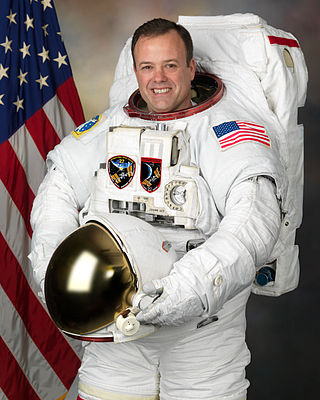
Ronald John Garan Jr. is a retired NASA astronaut. After graduating from State University of New York College at Oneonta in 1982, he joined the Air Force, becoming a Second Lieutenant in 1984. He became an F-16 pilot, and flew combat missions in Desert Shield and Desert Storm. Before becoming an astronaut he was the Operations Officer of the 40th Flight Test Squadron (FTS). He first flew in space as a mission specialist on the May 2008 STS-124 mission to the International Space Station (ISS). He returned to ISS on April 4, 2011, for a six-month stay as a member of Expedition 27.
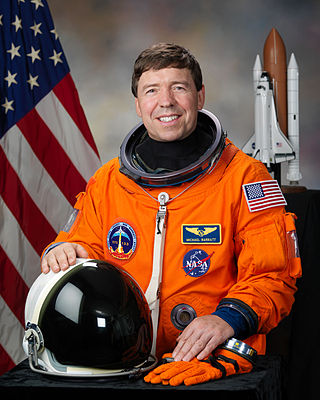
Michael Reed Barratt is an American physician and a NASA astronaut. Specializing in aerospace medicine, he served as a flight surgeon for NASA before his selection as an astronaut, and has played a role in developing NASA's space medicine programs for both the Shuttle-Mir Program and International Space Station. His first spaceflight was a long-duration mission to the International Space Station, as a flight engineer in the Expedition 19 and 20 crew. In March 2011, Barratt completed his second spaceflight as a crew member of STS-133.
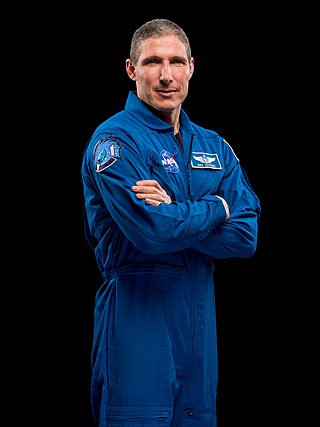
Michael Scott Hopkins is a United States Space Force colonel and NASA astronaut. Hopkins was selected in June 2009 as a member of the NASA Astronaut Group 20. He made his first spaceflight as a Flight Engineer on Soyuz TMA-10M/Expedition 37/Expedition 38, from September 2013 until March 2014. He is the first member of his astronaut class to fly in space. Hopkins is the first astronaut to transfer to the U.S. Space Force, participating in a transfer ceremony on the International Space Station.
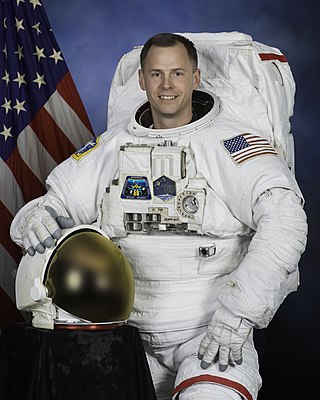
Tyler Nicklaus Hague is a United States Space Force colonel and a NASA astronaut of the class of 2013. Selected to be a flight engineer on the International Space Station, his first launch was on Soyuz MS-10, which aborted shortly after take-off on October 11, 2018. His second launch, on March 14, 2019, was successful, taking him and his fellow Soyuz MS-12 crew members to join ISS Expedition 59/60.
